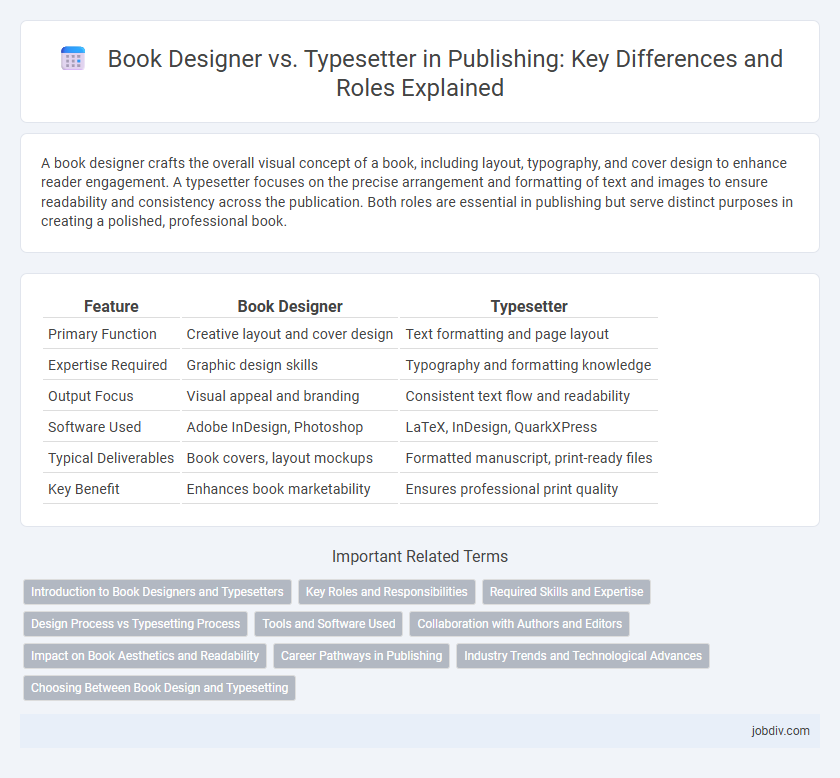A book designer crafts the overall visual concept of a book, including layout, typography, and cover design to enhance reader engagement. A typesetter focuses on the precise arrangement and formatting of text and images to ensure readability and consistency across the publication. Both roles are essential in publishing but serve distinct purposes in creating a polished, professional book.
Table of Comparison
| Feature | Book Designer | Typesetter |
|---|---|---|
| Primary Function | Creative layout and cover design | Text formatting and page layout |
| Expertise Required | Graphic design skills | Typography and formatting knowledge |
| Output Focus | Visual appeal and branding | Consistent text flow and readability |
| Software Used | Adobe InDesign, Photoshop | LaTeX, InDesign, QuarkXPress |
| Typical Deliverables | Book covers, layout mockups | Formatted manuscript, print-ready files |
| Key Benefit | Enhances book marketability | Ensures professional print quality |
Introduction to Book Designers and Typesetters
Book designers create the overall visual concept of a book, including layout, typography, and cover design, ensuring an engaging reader experience. Typesetters focus on the precise arrangement and formatting of text, applying the designer's style choices to produce clean, readable pages. Both roles are crucial in the publishing process to deliver a well-crafted final product that balances aesthetics and functionality.
Key Roles and Responsibilities
Book designers focus on the creative aspects of book layout, including cover design, typography, and visual elements that enhance reader engagement. Typesetters specialize in the precise arrangement of text on pages, ensuring consistent font usage, spacing, and alignment to meet print and digital publishing standards. Both roles collaborate to produce aesthetically pleasing and professionally formatted books that adhere to industry specifications.
Required Skills and Expertise
Book designers require proficiency in graphic design software such as Adobe InDesign and Photoshop to create visually appealing layouts and cover designs that enhance the reader's experience. Typesetters specialize in typography and text formatting, demanding expertise in tools like LaTeX or QuarkXPress to ensure consistent font selection, spacing, and alignment for optimal readability. Both roles necessitate a strong understanding of publishing standards and attention to detail, but designers focus more on creative aesthetics while typesetters emphasize precise text arrangement.
Design Process vs Typesetting Process
The book design process centers on creating the overall visual concept, including cover art, layout structure, typography choices, and graphic elements to achieve an engaging reader experience. Typesetting involves the precise arrangement of text within the layout, focusing on font size, line spacing, alignment, and hyphenation to ensure readability and print quality. While book designers establish the aesthetic framework, typesetters execute the detailed text formatting and prepare the manuscript for final printing or digital publication.
Tools and Software Used
Book designers primarily utilize software like Adobe InDesign and QuarkXPress to create visually compelling layouts and integrate typography with imagery, ensuring a cohesive aesthetic appeal. Typesetters focus on tools such as LaTeX, Adobe FrameMaker, and specialized typesetting software to format text accurately, manage spacing, and maintain consistency across manuscripts. Both roles require proficiency in software that supports precise control over fonts, alignment, and page structure to produce professional-quality printed or digital books.
Collaboration with Authors and Editors
Book designers collaborate closely with authors and editors to develop visual concepts that enhance the narrative and ensure the book's aesthetic aligns with the target audience. Typesetters work meticulously with these stakeholders to format text, ensuring readability and consistency across the manuscript while adhering to publishing standards. This collaboration guarantees a seamless integration of design and layout that supports the content's clarity and appeal.
Impact on Book Aesthetics and Readability
Book designers shape the overall visual identity of a publication by selecting typography, layout, and cover design to enhance aesthetic appeal and reader engagement. Typesetters focus on the precise arrangement of text and spacing within the pages, ensuring optimal readability and consistent formatting. Their combined efforts directly influence the book's accessibility, flow, and the reader's immersive experience.
Career Pathways in Publishing
Book designers focus on the creative aspects of book layout, typography, and cover design, shaping the visual identity of a publication. Typesetters specialize in formatting text and arranging it for print, ensuring readability and adherence to style guidelines. Career pathways in publishing for book designers often lead to roles in graphic design and art direction, while typesetters can advance into production management and digital formatting positions.
Industry Trends and Technological Advances
Book designers leverage advanced software like Adobe InDesign and Affinity Publisher to create visually compelling layouts, integrating typography, images, and branding elements that align with current market trends. Typesetters utilize automated tools and XML workflows to ensure precise text formatting and consistency, adapting to increasing demands for digital publishing formats such as eBooks and interactive PDFs. Emerging technologies like AI-driven design assistants and cloud-based collaboration platforms are transforming both roles by enhancing efficiency and enabling real-time project updates across publishing teams.
Choosing Between Book Design and Typesetting
Choosing between book design and typesetting depends on the project's needs, as book design involves the overall visual concept including cover art, typography, and layout, while typesetting focuses specifically on arranging text for readability and aesthetics. A book designer creates a cohesive look that aligns with the author's vision and market expectations, whereas a typesetter ensures the text's clarity and consistency across pages. Prioritizing book design is essential for branding and marketing appeal, whereas typesetting is critical for the professionalism and usability of the manuscript.
Book Designer vs Typesetter Infographic

 jobdiv.com
jobdiv.com